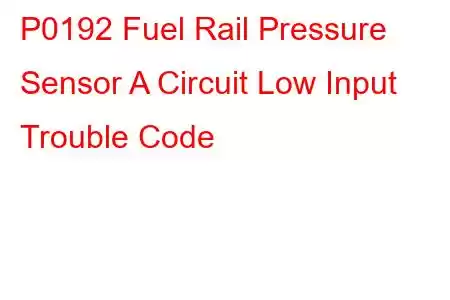P0192 Fuel Rail Pressure Sensor "A" Circuit Low
OBD-II Trouble Code Technical Description
Fuel Rail Pressure Sensor "A" Circuit Low
What does that mean?
This generic powertrain/engine diagnostic trouble code typically applies to most fuel injected engines, both gas and diesel since 2000. The code applies to all manufacturers such as Volvo, Ford, GMC, VW, etc.
This code is strictly concerned about the incoming signal from the fuel rail pressure sensor falling below a calibrated limit for a calibrated amount of time. This can be a mechanical or an electrical circuit fault, depending upon vehicle manufacturer, fuel type and fuel system.
Troubleshooting steps may vary depending upon manufacturer, type of fuel rail pressure system, and type of fuel rail pressure sensor and wire colors.
Symptoms
Symptoms of a P0192 engine code may include:
Malfunction Indicator Lamp (MIL) illuminated Lack of power Engine cranks but won't startCauses
Potential causes for this code to set are:
FRP signal short to SIG RTN or PWR GND Damaged FRP sensorDiagnostic and Repair Procedures
A good starting point is always to check for technical service bulletins (TSB) for your particular vehicle. Your issue may be a known issue with a known fix put out by the manufacturer and can save you time and money during diagnosis.
Next, locate Fuel Rail Pressure Sensor on your particular vehicle. It may look similar to this one:
Once located, visually inspect the connectors and wiring. Look for chafing, rubbing, bare wires, burn spots or melted plastic. Pull the connectors apart and carefully inspect the terminals (the metal parts) inside the connectors. See if they look corroded, burnt or possibly green in color versus the normal metal color you are probably used to seeing. You can get some Electrical Contact cleaner at any parts store if cleaning of the terminals is needed. If this is not possible, find some 91% rubbing alcohol and a light plastic bristle brush to clean them with. Afterwards let them air dry, get some dielectric silicone compound (same stuff they use for light bulb sockets and spark plug wires) and put some where the terminals come into contact.
Next, make sure that the vacuum hose that connects the sensor to the intake manifold is not leaking (if used). Visually inspect all vacuum hose connections at the FRP sensor and intake manifold. Note if any fuel comes out of the vacuum hose. If so, the fuel rail pressure sensor is defective. Replace as needed.
If you have a scan tool, clear the diagnostic trouble codes from memory, and see if this code returns. If it does not, then the connections were most likely your problem.
If the code does return, we will need to test the sensor and its associated circuits. Typically there are 3 wires at the FRP sensor. Disconnect the harness going to the FRP Sensor. For this code, the easiest thing to do is take a fused jumper wire (that’s a jumper wire with a fuse in line; it protects the circuit you are testing) and connect the 5V power supply wire to the FRP Signal input wire. With the scan tool hooked up, monitor the FRP Sensor volts. It should now read close to 5 volts. If a scan tool is not available that has a data stream, then see if code P0193 FRP Sensor Circuit High Input is now set. If either of these have occurred, then the wiring and PCM are good. The most likely problem is the sensor itself.
If all tests have passed so far, and you continue to get a P0192 code, this would most likely indicate a failed FRP sensor, although a failed PCM could not be ruled out until the sensor had been replaced.
CAUTION! On diesel engines with Common Rail Fuel Systems: if a fuel rail pressure sensor is suspected, you may want to have a professional technician install the sensor for you. This sensor may be installed by itself, or it may be part of the fuel rail. In either case, fuel rail pressure on these diesel engines at warm idle generally runs no less than 2000 psi and under load can well exceed 35,000 psi. If not sealed properly, this fuel pressure can cut skin open and diesel fuel has bacteria in it that can cause blood poisoning.
Read: 49


